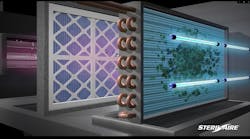For a healthy and productive indoor environment to be achieved, a mechanism is required to verify (1) the amount of outdoor-air (OA) ventilation being delivered to building occupants and (2) that the minimum ventilation required by ANSI/ASHRAE Standard 62, Ventilation for Acceptable Indoor Air Quality, is being provided. Carbon-dioxide- (CO2-) and cubic-feet-per-minute-(cfm-) based methods can help accomplish these goals.
Data quality varies significantly between CO2- and cfm-based ventilation assessments. Many of the differences occur because the CO2-based approach is dynamic, while the cfm-based approach is static. The CO2-based monitoring option can obtain more-robust feedback regarding ventilation performance than the cfm-based option can. However, quality-assurance measures need to be taken with a CO2-based approach for this potential to be realized. This article will discuss the advantages and disadvantages of each method.
CO2 - VS. CFM-BASED MONITORING
Each measurement of CO2 concentration reflects the time-integrated values of several factors, including the number of people present, their occupancy duration and activity level, and the amount of ventilation provided in the recent past. In contrast to this complexity, the cfm value is a measure of the volume of air moving through a duct at the instant of measurement.
The CO2-based approach relies on what is called an “end use” or “end point.” The cfm-based approach relies on a mid-point measurement of ventilation performance. For this method, the location at which cfm monitoring takes place represents a weakness because it does not include the ventilation performance of the HVAC distribution system downstream. Therefore, any local ventilation deficiencies that occur downstream of the cfm-measurement location would go undetected. This also can happen with CO2 monitoring, if it is assumed that the concentration measured at an air-handling unit's (AHU's) return serves numerous locations. In either case, errors also can be caused by supply-air (SA) leakage or a distribution of air that does not reflect the distribution of the people in the building. Monitoring end uses provides feedback that can help building owners and managers maintain efficient system performance and remedy any problems that may occur.2
SELECTING A MONITORING APPROACH
Choosing the optimum monitoring approach depends on the building in which the diagnostic feedback is to be obtained. Details such as building size, internal layout, and ventilation-system design influence this decision.
For example, in buildings in which a dedicated OA system is used, measuring volumetric outdoor airflow yields an accurate determination of the amount of air delivered to a space. The effectiveness of diluting and removing air contaminants from the space is not indicated by the cfm approach. It is, however, by the CO2-based approach.
CALCULATING OUTDOOR AIR
When the cfm-based approach is used in buildings in which OA ventilation is mixed as a percentage of SA, a problem can arise if this percentage is assumed to remain constant. Such an assumption is likely to occur if the percentage of OA in SA is based on a single test-and-balance measurement that occurs at HVAC startup. Monitoring data has shown that the percentage of OA can and does vary over time. Figure 1 shows an example in which the percentage of OA in SA not only varies considerably over time for a given AHU, but varies significantly among several AHUs intended to operate under similar conditions.
Section 11.5 of ASTM D 6245-98, Standard Guide for Using Indoor Carbon Dioxide Concentrations to Evaluate Indoor Air Quality and Ventilation, states, “If the occupancy of a building or zone is relatively constant, variations in the CO2 concentration can be used to indicate modulations in outdoor-air ventilation rates due to economizer operation or modulation of (variable-air-volume) systems.”2 This ability to assess time-varying ventilation performance highlights a significant difference between CO2- and cfm-based approaches.
With the CO2-based method, the determination of the percentage of OA in SA is based on a mass balance calculation of the CO2 concentrations in the OA, SA, and return air (RA) (Figure 2). In Figure 2, CO2 measurements were obtained with the same sensor that measured the air at occupied locations in the building. With this “shared-sensor” monitoring approach, the determination of the percentage of OA in the SA is accurate because the underlying calculation is based on the ratio of the difference between the RA and OA values over the difference between the RA and SA values. Even if the sensors were not calibrated perfectly, any offset from the true value would be applied equally to all three of these locations. Therefore, the determination of the percentage of OA still would be accurate. This shared-sensor approach relies on a network of sampling lines installed in the monitored building to provide a conduit that delivers air from each of the monitored locations to a central location in which the monitoring sensors are situated.
Again, this is different from cfm-based approaches, which typically rely on a temperature-based determination. This approach is limited in its accuracy because it is difficult to determine the temperature of a mixed air stream adiabatically before it becomes well-mixed and passes through any coils that add or remove heat.
IMPORTANCE OF KNOWING OUTDOOR-AIR VALUES
Another important aspect of CO2 monitoring is that outdoor concentrations can vary significantly from the 370 to 390 ppm expected in clean rural locations. For the urban location in Figure 2, outdoor CO2 concentrations were 430 to 470 ppm on the day measurements were taken. Therefore, because the CO2-monitoring determination of the ventilation rate is based on the difference between the indoor and outdoor concentrations, not having an accurate reading of the outdoor value can add uncertainty to the calculation. However, if the same sensor that is measuring the indoor concentration measures the outdoor CO2 concentration, this uncertainty evaporates.
Occupied space, not just the ductwork serving it, should be evaluated based on whether ASHRAE listed minimums are being met. Cfm-based approaches only indicate the volume of air potentially available for delivery, not the amount actually delivered. However, monitoring CO2 concentrations in occupied zones assesses the amount of OA used for ventilation in that space. Figures 3 and 4 indicate that significant variations can exist among various locations within buildings. In these examples, many locations have achieved ASHRAE-recommended minimums, but few locations have localized ventilation deficiencies.
LIMITATIONS OF CO2 MONITORING
One limitation of the CO2-based approach lies in its ability to determine actual ventilation rate. If a peak recorded value does not represent an equilibrium value, the amount of ventilation will be overstated. The monitoring data presented in Figure 4 demonstrates why this typically does not matter, if the goal is to determine whether ASHRAE-recommended minimums are being met. It cannot be determined from looking at Figure 4's peak values whether equilibrium conditions were achieved. Therefore, the ventilation rate may have been overstated. However, with peaks of 2,000 ppm and an outdoor concentration of 370 ppm, the calculation shows that no more than 6.5 cfm per person is being delivered. If the goal is to deliver 20 cfm of OA per person, ASHRAE minimums clearly are not being achieved.
This monitoring method requires data to be reviewed and logged information periodically interpreted. Unfortunately, too many engineers seem to equate CO2 monitoring only with its potential for control and do not understand and appreciate its value in providing diagnostic feedback on ventilation performance. Therefore, these important data-logging and review steps often are not performed.
The U.S. Green Building Council (USGBC) requires that CO2 concentrations be logged and reviewed in Leadership in Energy and Environmental Design (LEED) application submissions and that an example of monitoring data, as well as the identity of the person or firm responsible for reviewing it, be provided. Although the USGBC's Credit Interpretation Ruling states that the intent of this suggestion is to help achieve long-term occupant health and comfort, too many practitioners seem to think that simply having CO2 sensors generate control signals is sufficient for credit to be earned.
Figure 4 represents the problem of inferring localized ventilation rates in an RA stream at an AHU. This monitoring location fails to identify any localized ventilation deficiencies because it is not at the end point of the ventilation system, where people are located. This also serves to stress the need to understand the limitations of CO2-based monitoring and clearly spell out how this approach is to be used by LEED for Existing Buildings (LEED-EB) applicants to demonstrate that a ventilation system is delivering ventilation at the minimum ASHRAE-listed rates.
The location of a CO2-monitoring point also will affect data quality. If the sampling location is too near a person in the “breathing zone,” a 40,000-ppm exhaust plume could cause some spikes, decreasing the quality of the data. Standard ASTM D 6245-98 says: “The indoor concentration should not be measured close to people. A distance of 2 m from any occupant is sometimes suggested as sufficient to avoid these effects.”2
SIGNIFICANCE OF TIME-INTEGRATED MEASUREMENTS
As mentioned previously, the biggest difference between CO2- and cfm-based monitoring is that the CO2 approach is based on a time-integrated ventilation factor. This time-based sensitivity is significant because it can assess the ventilation-performance effectiveness of the overnight flushout of bioeffluents from the previous day's occupancy. The cfm-based approach can, at best, only estimate if bioeffluents were purged overnight. As building envelopes and damper seals become tighter, ventilation systems no longer are operating long enough to effectively purge buildings of bioeffluents overnight. Cfm-based ventilation monitoring lacks the ability to determine whether building occupants are reentering a building that has a bioeffluent residue left from the previous day. The CO2-based ventilation-monitoring approach automatically includes this determination.
In Figure 5, four independent data-logging sensors were moved among 14 locations to measure CO2 concentrations. As individual sensors, they seem to respond slightly differently to similar indoor conditions. This difference in sensor response, which occurs when multiple individual sensors are used, significantly increases the chance of error because the ventilation-rate determination is based on the difference between indoor and outdoor values. When utilizing different sensors, a rigorous program of calibration checks should be enacted to minimize the degradation of data quality inherent in multiple-sensor use.
In larger buildings — typically those that need to sample 20 or more locations — the economics of minimizing life-cycle costs favor a “shared-sensor” approach. According to this method, one sensor is used to measure all indoor and outdoor CO2 concentrations, eliminating the chance of errors stemming from differing sensor calibrations. The improvement in data accuracy is significant.
With the “shared-sensor” approach, sampling lines are installed to bring air samples from occupied spaces to a central location by vacuum pump and deliver the air samples to one CO2 sensor used in multiple locations. With this method, multiple gaseous indoor-air-quality parameters can be monitored simultaneously to provide a broad indication of the air quality being achieved. For example, absolute-humidity monitoring, which uses a chilled-mirror dew-point sensor, provides diagnostic feedback regarding the performance of dehumidification and humidification systems, the presence and impact of any indoor sources of moisture (intentional or not), and the existence of any moisture intrusions at the building envelope caused by infiltration or gaps in the architectural details.
CONCLUSION
CO2-based ventilation determinations can be more accurate than cfm-based approaches in assessing whether ASHRAE-listed ventilation minimums are being achieved. Therefore, LEED credits, especially those of LEED-EB, should be modified accordingly.
REFERENCES
-
Reiss, R. (2005). Improving the energy performance of green buildings. Boulder, CO: E Source.
-
ASTM International. (2002). Standard guide for using indoor carbon dioxide concentrations to evaluate indoor air quality and ventilation. ASTM D 6245-98. West Conshohocken, PA: ASTM International.
David W. Bearg, PE, CIH, holds a bachelor's degree in chemical engineering from Northeastern University and a master's degree in environmental health sciences from the Harvard School of Public Health. An accomplished author and speaker, he wrote the book “Indoor Air Quality and HVAC Systems.” He can be contacted at [email protected].








